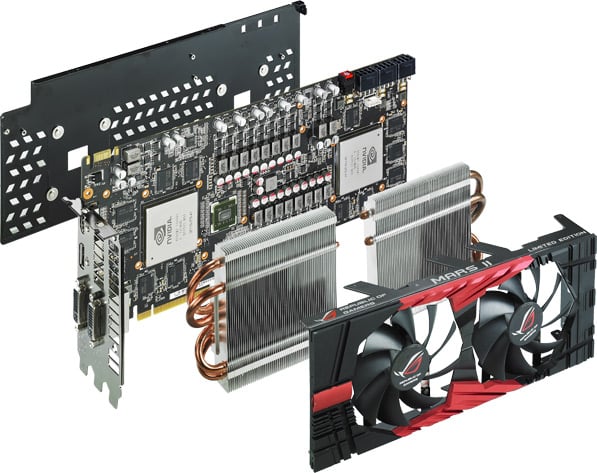ASUS MARS II Review: GTX 580 SLI On One PCB
The ASUS MARS II Card
Let’s get down to business. As we’ve mentioned, the Asus MARS II packs a full GeForce GTX 580 SLI, dual-GPU configuration onto a single board. Doing so required some significant engineering on Asus’ part to deal with the power and heat requirements of such a configuration. Asus pulled it off though, by equipping the MARS II with a new “SAP”, or Super Alloy Power VRM capable of 600W of power delivery, binning the GPUs, outfitting the GPUs with DirectCU heatsinks, and capping everything off with a pair of 120mm cooling fans.
The exploded view of the Asus MARS II above shows just how complex a product the card really is. The two large heatsinks rest directly atop each GPU. Memory chips flank three sides of each GPU with the SAP VRM smack dab in the middle. A heavy-duty metal backplane adds some much needed rigidity to the card and protects the entire backside. And a large shroud / fan housing covers the front. We should point out that the two fans on the MARS II are capable of pushing 220CFM. For comparison, the fan on a GTX 590 can move 32CFM.
Providing smooth, clean power is paramount for any graphics card, but especially for something as complex as the MARS II. To that end, Asus outfitted the card with a 21-phase VRM comprised of “super alloy” chokes, caps, and M.O.S.F.E.T.s, capped off my Asus’ super-hybrid engine. According to Asus, the SAP VRM “utilizes metals that are highly-magnetic, heat-resistant and anti-corrosive to reduce power loss, enhance durability and achieve cooler operation.” Also part of the SAP VRM is a pair of NEC / Tokin Prodalizers mounted directly behind each GPU. These prodalizers offer high capacitance and low ESR for clean power delivery and they’re placed as close to the GPUs are possible to increase efficiency and effectiveness.
Unlike the dual-GPU GeForce GTX 590, which is clocked much lower than the GTX 580, by going all out on its power delivery circuitry and cooling apparatus, Asus is able to provide a no-compromise (in terms of performance and features) GeForce GTX 580 SLI setup on a single-PCB, that runs at slightly higher stock frequencies than a pair of reference cards. The GPUs on the Asus MARS II are clocked at 782MHz (1564MHz shaders) and its 3GB of Samsung GDDR5 memory at 1002MHz (4008MHz effective). Reference GeForce GTX 580 cards have the same speed memory with GPUs that run at 772MHz.
As you look through the pics, you’ll notice the Asus MARS II requires a trio of 8-pin PCIe supplemental power connectors, for a total power (including the 75W available through a PCIe x16 slot) of 525W (150+150+150+75). To dissipate all the heat generated by a card that can use that much power, the two 120mm fans blow air directly onto the large heatsinks w/ copper heatpipes installed on each GPU. At idle, its fans generate about 21db of noise. When spun up to their max speed, the fans output upwards of 48.5db. Also note that there is a push-button switch right on the MARS II that will immediately run the fans at their maximum speed. Asus put that switch there for extreme overclockers that don’t want to mess around with software to tweak fan speeds.
In case you haven’t noticed up to this point, the Asus MARS II is huge. Really huge. The card measures in at 13” x 6.2” x 2.5”and almost 5.4lbs. It’s three-slots wide and dwarfs the Radeon HD 6990 and GeForce GTX 590. The thing is just plain imposing to look at.
Although it’s very big, Asus did make an effort to gussy up the card quite a bit. The backplate is perforated in a slick chevron pattern, the heatsinks in the front fan shroud mimic those on Asus’ Rampage series motherboards, and there is RoG—Republic of Gamers—messaging throughout. If you look close, you may even see the elongated “G” hiding behind the vents in the case bracket.
The Asus MARS II is a triple-slot solution, so you’ll need a board with enough room to accommodate this behemoth if you plan to get in on the action. On the card’s triple-slot case bracket its dual-DVI outputs, DisplayPort and HDMI outputs are visible. The MARS II does support NVIDIA 3D Vision Surround on its own. Not to mention, two cards can be paired together in a quad-SLI configuration as well. Good God.








